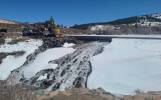NEVADA VIEWS: Time for realism on lakes Powell and Mead
On the Colorado River and its largest reservoirs, we have to start planning for long-term goals rather than bouncing from crisis to crisis.
In recent years, water managers have implemented quick fixes that haven’t staved off the inevitable declines in river flows. The 2019 Drought Contingency Plan, the 500-plus plan last year and the new efforts to prop up Lake Powell are symptomatic of the leapfrog management we’re seeing year after year.
You can’t blame state and federal officials for triaging the imminent needs for communities with slapdash policy. However, it is fair to ask: Is this sustainable?
If the Colorado River were a human body in distress, we could say that the current strategy is like trying to heal broken bones and flesh wounds with bandages rather than major surgery, casts and physical therapy.
Things are going to continue “going south” in the coming years as it relates to the hydrology. Maybe a big water year or two will act as a natural tourniquet. But research suggests that we have not yet hit the floor for decreasing flows.
One effort to help mitigate future river maladies: Ensure that Congress invests more in the Bureau of Reclamation, the agency tasked with managing the Colorado’s flows, electricity generation and dams. Specifically, Congress must increase the funding for research and analysis about what the future holds.
Much of this should be directed at how we manage Lake Powell. We are in unchartered territory as it relates to operating the nation’s second-largest reservoir. The idea of decommissioning the dam and draining Lake Powell was once considered radical. Mother Nature is proving the radicals’ warnings were not beyond the pale.
Whether it is sediment, water temperature, species, evaporation, seepage and other aspects of water management, there is a growing need for data more than ever before at Glen Canyon Dam — which has a symbiotic, hydro-geographic and hydrologic connection to Lake Mead. Additionally, there are also questions about some of the reservoir’s major functions: generating electricity and delivering water to communities such as Page, Arizona, and the LeChee Chapter of the Navajo Nation — two communities that will not be able to continue drawing water out of Lake Powell as they have in the past.
If we can’t get more water on the river, we at least need more brainpower. To that end, I helped form a coalition that is offering a $10,000 prize for engineers and engineering students who submit the best designs for rewilding Glen Canyon and decommissioning the eponymous dam (rewildingcoloradoriver.org/). Indeed, students and private citizens can help get the ball rolling. But Congress can galvanize this effort even more than it already has. The bipartisan infrastructure bill did include funds to bolster operations. But as this water year demonstrates, we have not gone far enough.
I have been an outspoken critic of the nation’s second-largest reservoir — working with activists who foresaw the potential for problems when Lake Powell began filling behind Glen Canyon Dam in 1963. Unfortunately, a mix of cognitive dissonance, political intransigence and brief wet periods have made it untenable to study a full suite of future scenarios.
As many know, flawed hydrology has driven Colorado River management since 1922. The wishful-thinking mindset still plagues — as it has for a century — river management.
Yes, we need to invest in science. But of greater importance, we need science that the states and other power players cannot ignore. We have to stop hoping a big winter will solve our problems.
In 2007, many Colorado River interests (30 tribes were shut out) created what’s known as the Interim Guidelines. This management framework went through a federal environmental review and got the blessing of the Colorado River states and federal officials. This effort intended to protect reservoir levels and secure water for 40 million people. Unfortunately, water managers chose to be optimistic rather than realistic.
It’s disheartening to look at the hydrologic modeling used to derive that management agreement. The data put forth a decade ago made it seem like a safe bet that Lakes Powell and Mead would be 100 feet higher today. The data implied that the levels we are now managing would not likely exist. However, in that era, academics were doing some modeling of their own, predicting what we’re seeing today. What did the scientists tell the states and federal government back then: Balance demand with supply.
That never happened. Let’s not repeat the mistakes of the past.
We are in the driest period in 1,200 years. We need an unprecedented intervention where we diagnose, treat and rehabilitate our relationship with the river and its tributaries. The truth hurts on the river today. But the pain will be much worse if we don’t correct our course now.
Tick Segerblom, a Democrat, is a former state lawmaker who now represents District E on the Clark County Commission.




























